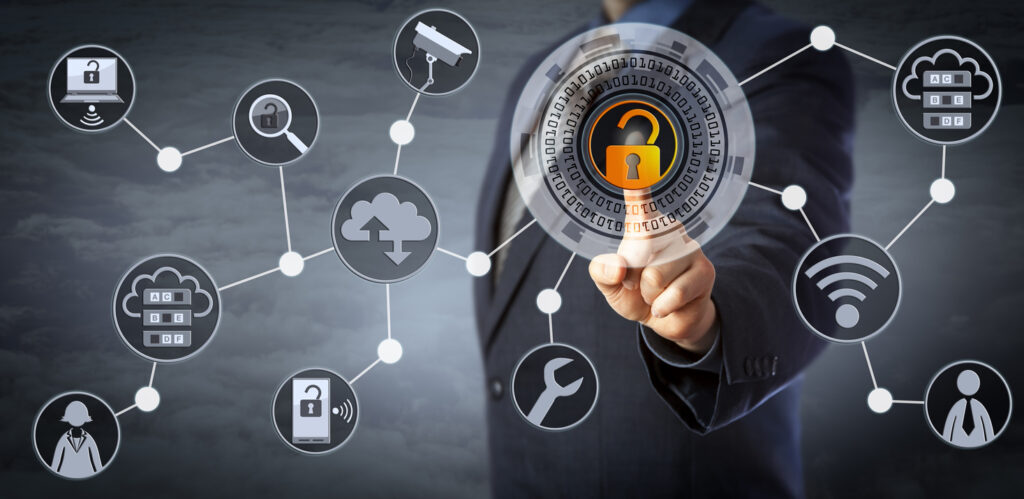Everyone is talking about digital transformation. It helps companies to improve the customer experience, simplify business processes and prepare for future challenges and business requirements. However, this modernization also poses new challenges in terms of cyber security and data protection. This is because the use of local and multi-cloud/remote environments means that users can access data from anywhere. Identity governance is therefore shifting with the use of identity federation and personal devices (BYOD). At the same time, the number of data access points, roles and user accounts is increasing – including privileged accounts. In such a complex IT ecosystem, it is difficult to manage and control identities and their access effectively.
Attacks on identities are a daily routine
It is well known that the top management level is directly responsible for its corporate risks and consequently their management. This also includes risks relating to Identity Governance & Administration (IGA), as they have a major impact both operationally and financially. Identifying and managing identity-related risks is fundamental, as the consequences of a security breach in connection with identities range from reputational damage to financial losses in the form of fines or ransomware payments.
In order to create effective risk-based access and identity management programs, the focus is on the risks of each individual identity:
- Who has access to key enterprise applications (legacy and cloud)?
- What risk does this access pose to the organisation?
- Why is there access and is it appropriate?
- Is there an audit plan for the application and review process?
- How is access utilised from a business risk perspective?

These risks have been exacerbated by the global pandemic, but the theft of access data is also on the rise. In this regard, we recommend focusing on distributed, remote workplaces and employees as well as efficient monitoring of digital threats and the fulfilment and assessment of legal and industry-specific data protection and security requirements. It is also advisable to check access to sensitive customer and financial data as well as transactional processes.
Identities take centre stage
Today’s requirements are forcing companies to place identity and its context at the centre. For example, an identity can be both an employee and a customer, a doctor can be a patient or an employee can be a citizen. In combination with agile business models, job sharing, job rotation, etc., access management has evolved from a traditional perimeter-based to an identity-centric approach.
We see time and time again that organisations struggle with the following four areas in particular:
- Integration of cloud into non-standard, centralised Identity & Access Management (IAM) solutions;
- Integration of IAM into DevSecOps processes;
- Integration of Internet of Things (IoT) into Identity Governance & Administration (IGA);
- Fulfilment of audit security and compliance requirements
A holistic Identity Governance & Administration (IGA) that not only targets cloud, hybrid and/or on-premises security, but also the expectations of users and companies with regard to data protection, data security and cyber security can provide a remedy here.
IGA solves open issues in IAM
IGA is an important aspect of managing and controlling identities and the corresponding access authorisation. At the same time, IGA helps to solve IAM challenges such as inappropriate and/or outdated access to company resources, remote employees, time-consuming provisioning processes, weak Bring Your Own Device (BYOD) policies or strict compliance requirements. All of these issues increase the security risk and weaken the compliance position of companies.
With IGA, companies can automate their access management workflows extensively – even beyond their own perimeter – and thus reduce risks. IAM guidelines can also be defined and implemented. Last but not least, this enables companies to actively review user access processes for compliance reporting and proactively initiate automated measures. For this reason, more and more companies are modernising to IGA in order to continue to meet the increasing compliance requirements of eHealth, SOX, ISO/IEC 27701, PCI DSS etc. in the long term. But it’s not just compliance that benefits from IGA!
IGA improves the overview of what users can and cannot access. This enables IT administrators to optimise identity management and access control, efficiently mitigate risks and protect business-critical systems and data. With the right IGA tools, organisations can protect themselves in today’s complex IT and cyber security landscape, improve their resilience and achieve scalable growth.
Business-to-identity as a key element
IGA is the secret supreme discipline in the areas of governance, risks and compliance. Identity Governance & Administration with all its disciplines such as Privileged Access Management (PAM), Customer Identity & Access Management (CIAM) etc. are key functions for strategic security objectives such as: Zero Trust Completeness, Need-to-know, Security by Design, Security by Default.
A central element in identity-centric management is to place identity at the centre of security strategies, based on a business-to-identity framework with IGA. Such a framework includes best practices for effective management of the identity-related threat landscape, overcoming hurdles in the context of automation and ensuring security by design in the centralised governance of identities. IGA tools also support the tracking and control of user access, both for local and cloud-based systems. This allows you to ensure that the right users have the right access to the right systems throughout the lifecycle, as well as detect and prevent unauthorised access.
By implementing the right controls with Identity Governance and Administration, organizations can significantly enhance their security posture, ensure compliance with regulatory requirements, and streamline user access management to improve efficiency. IGA solutions provide a comprehensive framework to manage digital identities, define and enforce access policies, conduct access reviews, and generate audit-ready reports. This holistic approach not only reduces the risk of data breaches but also enables businesses to adapt rapidly to changing security landscapes and align IT processes with corporate governance objectives.
